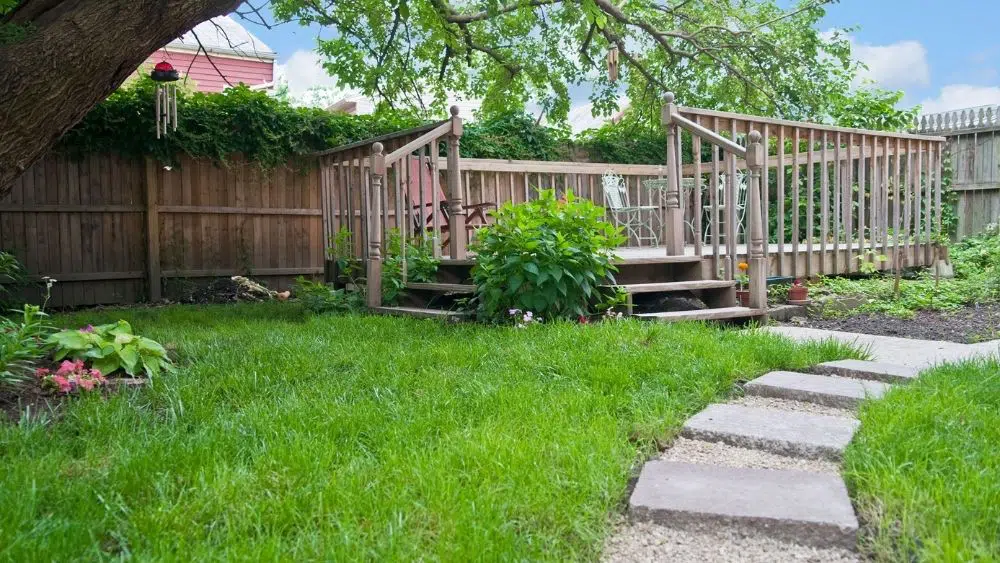
Love spending time outdoors but want to stay within the comfort of your own home? We have identified several new ways homeowners can elevate and maximize their backyards to make it a fun and relaxing experience.
How can you maximize your outdoor space for entertaining and unwinding? Add a floating deck and enhance your yard’s visual appeal. This outdoor addition, also known as a freestanding deck, is a wooden deck that’s not attached to a wall or part of the home. A floating deck is elevated above ground and is supported by concrete or cement blocks. Its construction gives the illusion the deck appears to float or hover above ground.
Why should you consider a floating deck? For starters, it creates more usable space in back or side yards. And though a freestanding deck is easy to install, it also supports a natural environment, as floating decks don’t disturb plant life or tree roots. Did we mention that floating decks cost less in comparison to traditional decks? Well, their costs are significantly lower, adding to their overall appeal.
With this in mind, there are a few things to know before adding a freestanding deck to the yard. Since these decks are not attached to the home, permits are not usually required. However, it’s essential to check with local departments. From there, confirm where the floating deck will be placed – this should be aligned with usage, intended activities, and even landscaping ideas. It’s better to lock down the entire picture before getting started.
Next, finalize all the nitty-gritty details: measurements, budget, and confirmation from your builder or contractor. Then, you can compile a mood board for wood finishes, paint, greenery and landscaping, and outdoor furniture and art.
How to Add a Floating Deck

What You Need to Begin
Building a floating deck isn’t overly complicated and it’s rather cost-effective to boot. Here’s what you need to get started:
- 150-200 feet of space
- Pressure-treated lumber (cedar, pine, redwood)
- Concrete footings (approximately 36 – 48 inches deep)
- Framing connectors
- Equipment tools (rake, shovel, circular saw, tape measure, level, drill and drill bits)
- Soil
- Safety tools (googles, gloves)
- Deck layout plans
If you’re a DIY pro or semi-pro, it’s possible to build a floating deck over a weekend. The project may take 8 -12 hours, so if time isn’t on your side, you may want to hire a contractor.
Maintaining a Floating Deck

Once the freestanding deck is installed, you’ll want to keep it in tip-top shape. Stick to a regular cleaning and maintenance schedule to ensure that the deck maintains its luster. Plus, you’ll want to do a deep clean–like a power wash–once or twice a year to keep it sparkling.
But that’s not all. To keep the freestanding deck in its best possible condition, homeowners should remember to seal the wood. Remember to stain and seal the deck every two to three years to protect it from the elements.
Floating Deck Accessories
You can leave your new floating deck plain vanilla – or you can embellish it. There is so much on the market to explore, and we have a few listed below. Consider these tiles, outdoor furnishing, and landscaping add-ons to optimize this brand-new space.
Patio furniture set
Tie everything together with furniture that will make the new deck the ultimate gathering space. A stylish set invites togetherness.
Hammocks
Getting away from it all isn’t just a catchphrase; it is important for our health and well-being. Consider adding a hammock to your freestanding deck where you can escape to read, relax, or nap.
Pergolas and Umbrellas
Why not mix in a little shade? Pergolas define gathering spaces and regulate the sun’s rays. Umbrellas are similar but usually smaller in size. Either one is a great addition when you are in the mood for outdoor dining and entertaining.
Planters and Stands
Lush greens and vibrant plant life add a kick to landscaping. From potted plants to stands and planters, add more nature to your deck.

Stephanie Valente is a Content Director and Editor in Brooklyn, NY. She’s previously held writing and social media positions at Barkbox, Men’s Journal, and currently works at a full-service advertising agency. She’s a self-confessed home and design enthusiast. Stephanie is an award-winning poet and fiction writer. When she’s offline, you can find her taking a yoga class, running, hanging out with her rescue dog Pepper. Find her on stephanievalente.com.
 The Best Places to Retire in Wyoming
The Best Places to Retire in Wyoming